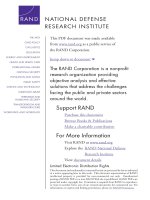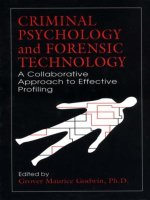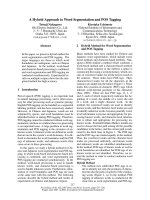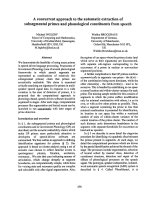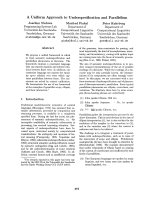Ebook Managing corporate reputation and risk: Developing a strategic approach to corporate integrity using knowledge management – Part 1
Bạn đang xem bản rút gọn của tài liệu. Xem và tải ngay bản đầy đủ của tài liệu tại đây (602.52 KB, 95 trang )
Managing Corporate
Reputation and Risk
Developing a Strategic Approach to
Corporate Integrity Using Knowledge
Management
This Page Intentionally Left Blank
Managing Corporate
Reputation and Risk
Developing a Strategic Approach to
Corporate Integrity Using Knowledge
Management
D N
Amsterdam Boston Heidelberg London New York Oxford
Paris San Diego San Francisco Singapore Sydney Tokyo
Butterworth–Heinemann is an imprint of Elsevier.
Copyright © , Dale Neef. All rights reserved.
No part of this publication may be reproduced, stored in a retrieval system, or transmitted in
any form or by any means, electronic, mechanical, photocopying, recording, or otherwise,
without the prior written permission of the publisher.
Recognizing the importance of preserving what has been written, Elsevier Science prints
its books on acid-free paper whenever possible.
Library of Congress Cataloging-in-Publication Data
Neef, Dale, –
Managing corporate reputation and risk / Dale Neef.
p. cm.
Includes bibliographical references and index.
ISBN ---
. Corporate image. . Corporations—Moral and ethical aspects. . Business ethics.
. Integrity. . Risk management. . Knowledge management. I. Title.
HD..N
.–dc
British Library Cataloguing-in-Publication Data
A catalogue record for this book is available from the British Library.
The publisher offers special discounts on bulk orders of this book.
For information, please contact:
Manager of Special Sales
Elsevier Science
Wheeler Road
Burlington, MA
Tel: --
Fax: --
For information on all Butterworth–Heinemann publications available, contact our World
Wide Web home page at:
Printed in the United States of America
Table of Contents
Introduction
vii
Part One: The Case for Greater Integrity
Chapter One: New Ethical Concerns for the Modern Corporation
Chapter Two: Making the Business Case for an Integrated
Program of Ethics and Knowledge Management
Chapter Three: Key Areas of Risk: Where Knowing What is
Happening Really Matters
Chapter Four: How Have Corporations Responded?
Part Two: A Program for Corporate Integrity
Chapter Five: Moving Beyond Stage Two
Chapter Six: Establishing and Managing an Ethical Framework
Chapter Seven: Understanding the Value of Knowledge and Risk
Management
Chapter Eight: Integrating Ethics, Risk, Standards, and
Knowledge Management into an Ethical Framework
Chapter Nine: Creating a Culture of Integrity and Knowledge
Sharing
vi
T C
Chapter Ten: Systems That Support Integrated Knowledge and
Risk Management
Chapter Eleven: Choosing and Implementing Standards
About the Author
Index
Introduction
This book is about what a company needs to do to manage its integrity
and to avoid making the kind of mistakes (an Environmental
Protection Agency [EPA] fine, a product safety disaster, an employment lawsuit, an overseas worker exploitation charge) that can lead to
penalties, a loss of share value, and a damaged corporate reputation.
Integrity in business has never been more important. In many ways,
companies have a lot more to lose today than even years ago, simply
because the potential for being caught and exposed—by activists,
lawyers, prosecutors, government agencies or the media—is greater
than ever before. The penalties are larger—loss of share value, consumer boycotts, lawsuits, greater regulation—and more personal, with
executives and board members increasingly being held accountable for
the actions of the company with heavy personal fines and even imprisonment. The triple combination of personal-incentive–based pay, new
levels of empowerment, and a leaner, more aggressive economy means
that employees at all levels, as never before, are caught in that tug-ofwar between doing what is right and doing what their superiors want
and need, in order to achieve unrealistic targets. To avoid these types
of disasters, companies need to do more than simply give money away
in philanthropic gestures and claim that they are “socially responsible.” They are going to have to start actively managing their risk in a
much more effective way.
Putting aside some obvious cases of pure malfeasance on the part
of corporate executives in recent scandals, the fact is that most
viii
I
reputation-damaging incidents happen because company decision
makers, corporate officers, or board members simply don’t know
what is going on in their own organization. There are hundreds of
good examples which demonstrate that if executives or senior
managers had only known what was happening, they would have
taken preventative action. The fact that they didn’t know provides a
compelling case for better knowledge management in the modern
company.
What do companies need to do in order to avoid making costly and
self-destructive mistakes? In this book, we look at the best-practice
techniques that companies can use to protect their integrity and to
avoid these costly blunders.
There are three important areas of focus. First, a company has to
actively manage its process for ensuring corporate integrity. This
means telling your employees that you expect—that is, require—
ethical behavior and then putting together a better process for encouraging, monitoring, and enforcing that behavior by having employees
at all levels of the company participate actively in anticipating and
resolving ethical or legal issues. In short, companies need to establish
a strong and effective ethical framework.
Second, a company has to actively gain a better understanding of
what is happening both internal to the company and in the outside
world so that it can sense potential problems and react to them in a
responsive and ethical way. The good news is that never have we had
so much knowledge and information at our fingertips or better techniques and systems to help us access, analyze, and act on that knowledge. This process is called knowledge management.
After all, whether it is a board not knowing that executives are completing off-the-books partnerships with company money or senior
management having no idea that operational employees are dumping
toxic wastes down local wells, these things are still essentially colossal
failures of knowledge management. And as new punitive regulations
from the U.S. sentencing guidelines agency and recent legislation such
as the Sarbanes-Oxley act demonstrate, the excuse that “we didn’t
I
ix
know” what was happening is no longer valid. Companies are today,
more than ever before, expected—again, required—to know about and
be responsible for the actions of their employees. Increasingly, a failure
to manage company integrity can lead to severe penalties for the
company and for executives themselves. In today’s climate, “we didn’t
know” is no longer considered an excuse; it is considered to be
negligence.
What is needed then is to apply many of the same knowledge management techniques and systems that have worked so successfully
during the past years in the operational world to a company-wide
process for actively managing risk. It isn’t that expensive, and it isn’t
even that difficult, but it doesn’t just happen on its own; it’s something
that companies need to actively manage.
As the more progressive companies can demonstrate, applying these
types of knowledge management techniques have many important
benefits. Knowledge risk management (KRM) allows a company to
anticipate issues, to avoid risks, and to behave more responsively and
acceptably. It also applies many of the same tenets of quality management and can be used to improve processes, reduce waste and costs,
and increase productivity. In short, using KRM to actively manage a
company’s integrity moves a company one step up the evolutionary
ladder toward becoming both a more ethical and a more efficient
organization.
Finally, not only is it important that companies actively manage
their integrity, but it is also important that they can demonstrate
to the outside world, including investors, activists, and consumers,
that they are doing so. For this, a company needs to apply
internationally recognized standards and to report their performance
against those standards in a clear, accurate, and verifiable way.
This can best be achieved using new triple–bottom-line reporting
techniques that provide a broader and more accurate view of their
organization’s activities—financial, corporate governance, social, and
environmental—for shareholders, analysts, pressure groups, and the
media.
x
I
These three elements—developing a strong ethical framework,
actively pursuing KRM, and reporting on those efforts using
triple–bottom-line reporting techniques—are key to managing
integrity in the modern corporation. It has never been more easily and
efficiently done, and it has never been more important.
P O
The Case
for Greater
Integrity
This Page Intentionally Left Blank
ONE
New Ethical Concerns
for the Modern Corporation
A -month-old child dies from drinking bacteria-laden apple juice
after a company ignores advice concerning the product’s safety. A
slaughterhouse is found dumping waste, chicken blood, and entrails
into one of Mississippi’s main water systems. A children’s safety seat
manufacturer fails to reveal to the public dangerous defects in its car
seats, cribs, and strollers that kill two babies and injure more than
others. Enron collapses, costing employees millions of dollars in
pension losses. Merrill Lynch agrees to pay $ million in fines for
touting stocks that its own analysts expected to lose money. Hundreds
of listed companies are forced to restate their profits, caught
red-handed in financial manipulation and deception.
Why do these things continue to happen? Just when economists,
politicians, and business leaders were declaring the final triumph of
free-market capitalism over central planning or government intervention in markets—just when the doctrine of corporate voluntary compliance was beginning to make headway against overregulation—it
seems as if all the concerns and accusations levied by pressure groups
against companies are justified.
Maybe it is because we were beginning to believe the constant
upbeat advertising, the incessant almost orwellian re-branding, the
slogans, the music, the pictures of happy children, pristine lakes, and
dedicated employees that fill the airwaves, billboards, and the
T C G I
Internet, thrown at us by corporate public relations campaigns. Facing
activism from anti-capitalists, corporations over the past years have
clambered to raise their ethical profiles by presenting themselves—
through philanthropy, community assistance, public relations programs, and advertisements—as caring and socially responsible
companies.
We found ourselves suddenly disillusioned again, though, by a
series of company scandals in /, including those that
led to the most devastating bankruptcies in corporate history. Of
more concern, however, is that those executive-led accounting
scandals are only the tip of the iceberg. Companies are continuing to
do unethical and harmful things much as they always have, and they
continue to be caught and fined in record amounts. There are many
examples.
• In BP-Amoco pleaded guilty to a felony charge
involving the illegal dumping of toxic waste at its Endicott oil
field on the North Slope and was fined $ million in civil
and criminal penalties.
• According to a report by the Michigan Occupational Safety
and Health Administration (MIOSHA) following a -month
investigation, top Ford officials were well informed of the lifethreatening hazards at their Dearborn, Michigan power plant
before the explosion in that killed workers and severely
injured others. According to MIOSHA, the reason, in part,
that the study took so long to complete, was general
obstruction in the investigation by Ford, including refusal to
make safety records and other documents available. The report
revealed that the gas explosion would not have occurred if
Ford had installed a ventilation system that had been
recommended by an internal Ford audit, by its insurance
carrier, by an outside consulting firm, and by a joint
Ford–United Auto Workers report. In September of that year,
Ford agreed to pay $ million in settlement.
N E C M C
• Texaco, accused of race discrimination by six employees,
agreed in to pay $ million in settlement and $
million more to improve the racial climate in the company.
The story was carried in newspapers and on television
worldwide and came on the back of a devastating recording
of executives in a meeting, reported in the New York
Times, using racial slurs against minority employees even
as they discussed destroying documents linked to the
lawsuit.
The list of company disasters goes on and on: Enron, Tyco, Global
Crossing, Coca-Cola, BP-Amoco, De Beers. . . . It is not only large
multinationals, of course. Small and medium-sized companies continue to be found dumping toxic wastes, violating employment
legislation, and creating and distributing unsafe products.
• Central Industries, a Mississippi poultry waste processor, was
assessed some $ million in fines and damages for dumping
slaughterhouse waste—including feathers, entrails, and body
parts—into a tributary of the Pearl River, part of Mississippi’s
central water supply.
• DoubleClick, the Internet advertising business, was forced to
suspend its policy of implanting electronic surveillance files—
cookies—on Web surfers’ hard drives without their
knowledge. Accused of using information collected to compile
and sell user profiles linked to e-mails (and therefore names
and addresses), the company was forced to restrict its online
profiling service through a settlement made after several states
began legal action under the Consumer Protection Act. Not
only is its brand name now synonymous with privacy
violations on the Internet, but its share value has plummeted,
it has been the subject of a Federal Trade Commission
inquiry, has faced investigations by the states of Michigan and
New York, and is involved in six related lawsuits.
T C G I
• Cosco, the largest manufacturer of baby strollers and car seats
in the United States agreed to pay $. million as settlement
after the Consumer Product Safety Commission (CPSC)
charged the company with failure to inform the CPSC or the
public of product defects with its cribs, strollers, car-seat
carriers, and high chairs that caused the deaths of two babies
and injured more than children.
The litany of callous, illegal, and unethical corporate behavior is
breathtaking. Yet, none of these calamities came about because of
natural disasters or unforeseeable events: They were man made and
easily predictable. They came about either because company employees were purposely pursuing policies outside of boundaries of the
public’s ethical acceptance (a failure of a company’s ethical policy), or
almost worse, executives and board members did not know what policies their company was pursuing (a failure of knowledge management).
T C
As a result, of course, there has been a severe and predictable backlash. The combined effect of the scandals and the collapse in the
dot-com market in the United States, Europe, and Japan has resulted
in record bankruptcies, plunging share prices, and unprecedented
penalties and fines for once well-known and trusted companies. New
legislation in Europe, Canada, Australia, and Japan is set to ensure
greater transparency and reporting on corporate governance, social,
and environmental issues, requiring companies to begin demonstrating greater transparency by adding corporate governance, social, and
environmental performance reviews to their annual reports.
In the United States, the Sarbanes-Oxley Act regulating financial
service companies has been rushed into existence in the face of scandals, cobbled together with a frightening juxtaposition of all-encompassing rules and special exemptions. Chief executives now have to
confirm by signature the validity of their financial reports, at risk of
N E C M C
heavy personal fines and imprisonment if those figures, under audit,
turn out to be invalid. Those accountancy groups that remain—
after Andersen’s ignominious collapse—have pledged to apply unprecedented rigor in future audits. And the public perception of
the integrity of business advertising and business leaders is at record
lows.
Further, as revelations of corporate wrongdoing have surfaced and
the general outrage at corporate misbehavior has grown, penalties have
become more stringent and more focused on personal, rather than corporate, responsibility. Each week brings footage of the newest “perp
walk,” with company executives, pale and bewildered, occasionally
handcuffed, being escorted into court, with somber lawyers at their
side. In the United States the Sentencing Guidelines Commission has
made it clear that executives and board members who have not taken
the appropriate precautions to guard against illegal or dangerous activities by their company can be held personally responsible—through
fines and imprisonment—when these catastrophes do occur. Australia
has just enacted a similar set of laws in its Commonwealth Criminal
Code, and in Canada passed the Toughest Environmental Penalties Act, which includes a SWAT team to sweep down on businesses
and allows fines for individual employees and executives of up to $
million (Canadian) per day, with jail terms of up to years.
At the same time, the Internet and CNN now provide a new and
powerful communication medium for “business bashing,” and a greatly
expanded and voracious business press combine with powerful and
effective nongovernmental organizations and pressure groups to
provide unprecedented levels of scrutiny of company behavior. This
makes companies vulnerable to almost instant repercussions for a corporate blunder. A corporate scandal can overwhelm a company in a
matter of days, sullying reputations—Nike, Firestone, Enron, Tyco,
Andersen—and leading to plunging share values. An incident involving child welfare, a product safety claim, or an Environmental Protection Agency (EPA) violation can quickly erode investor confidence,
and if egregious enough, once publicized by pressure groups, can even
T C G I
lead to consumer boycotts, undermining the company’s strategic flexibility, demoralizing the employees, and ultimately threatening the
company’s “license to operate.” Punishment for bad behavior can be
ruthless, particularly by shareholders, analysts, and banks.
Affected by a new level of global turmoil that began with /, the
global economy remains weak, promising to keep markets unstable for
some time. Yet those markets—particularly Wall Street—remain
focused on the all-important quarterly profits report. This continues
to drive companies to take extraordinary measures—and risks—in
order to maintain their share price in a never-ending struggle to maintain the impression of high growth.
This weakened economy, of course, only compounds the relentless
pressures that force companies to cut costs, find ways of generating
ever greater efficiencies, and expand their reach into global markets.
In fact, with the downturn in the global economy since , the pressure to perform has increased, as companies continue to announce
weak quarterly results and poor long-term forecasts. With fudging the
numbers no longer an option, this has driven organizations to continue to outsource, to expand their supplier base, or to relocate their
manufacturing sites to developing countries, seeking lower labor costs
and less regulation.
Of course, with the global extension of their supply chain, an organization assumes a greater level of risk—from labor issues, corruption,
or loose environmental standards—that can affect their overseas operations, and once discovered, rock their operations at home. These sorts
of incidents can suddenly make a good company seem callously indifferent and uncaring, with graphic pictures of poor working conditions
or illegal chemical disposal being shown on the evening news in
London, Toronto, or Chicago.
W G C D B T
Yet, companies still continue to commit egregious blunders on an
almost daily basis. Why does this continue to happen? Why would a
N E C M C
modern American company continue to dispose of illegal toxic wastes
(or chicken carcasses) despoiling the environment, putting workers
and the public at risk, with a very good chance of being caught and
fined? Why do companies continue to ignore critical audits or internal warnings even though this may harm employees, the public, and
ultimately their own company’s reputation?
There have been many theories put forward about why good companies can do such bad things. One possible explanation lies in the
new organizational and personal performance incentives that have
been developed over the last decade and that have altered the traditional, more hierarchical, risk-averse and approval-focused organizational structures of the past. As the de-layering and downsizing
continues, employees today have at once both greater freedom of
action and more personal responsibility than ever before.
At the same time, personal incentive plans, ubiquitous now at every
level of the organization, have made it possible for management to
manipulate and focus employee performance, increasing productivity
and efficiency. Working ever longer hours, a large component of the
earnings of most salaried employees today are dependent upon achieving goals that reflect the ultimate concern of the company itself, that
is, making the numbers each quarter.
These efficiency improvements, however, have not come without a
price. As expectations for lifetime employment and single-company
loyalty have faded, employees have become much more likely than ever
before to sue their company or to take a workplace complaint into
litigation. And with an increasing portion of their personal income
dependent upon bonuses that are tied to high performance, the risk
that employees will do whatever is necessary to achieve the desired
results—cook the books, pay the bribe, or illegally dispose of waste
materials—continues to grow. After all, despite their proclamations of
being an ethical company and considerable contributions to worthy
causes, Enron employees were under no illusion that if they did not
make their quarterly numbers, they would lose a good portion of their
earnings and face being summarily fired.
Tai lieu. Luan van. Luan an. Do an.
T C G I
This feeling seems to be endemic to modern business. A recent
survey by the Ethics Resource Center found that percent of respondents believed that their supervisors didn’t set good examples of
integrity, and nearly the same number felt pressured to compromise
their organization’s ethics on the job. When just less than one half of
a country’s employees are compromising their ethical standards under
pressure from management, something is very wrong with our organizational culture.
In this type of culture, creativity and innovation soon became code
words for illegal or unethical policies. It is a peculiar irony. We in business have become so skilled at encouraging people through personal
gain to be productive for the company as a whole that we have turned
a blind eye to the downside of this new attitude. Today, more than
ever before, unethical or illegal behavior instituted by “creative”
employees (such as those at Andersen, Tyco, Enron, or Barings) can
mean the destruction of the corporation itself.
There have also been several fundamental changes to the organizational structures of the modern corporation in the past decade that
have contributed to the likelihood of disasters. With global expansion
of their supply chains, companies have inherited (usually unwillingly)
extended responsibilities for the actions of third-party factories in
developing countries, where their own reputation can be tarnished by
local employment or environment violations. Fair or not, for example,
for many people Nike is now synonymous with the term “sweat shop”
because of its ruinous association with poor Southeast Asian factory
practices. A single major incident can be disastrous to a company’s
reputation, and it takes a long time to regain that reputation through
good works, or even, in Nike’s case, diligent attempts at reform.
But We Didn’t Know . . .
These are all contributory factors that may help to explain why
companies continue to do things that are unethical and ultimately
self-destructive. However,
apart from the more general issue of
Tai lieu. Luan van. Luan an. Do an.
N E C M C
new organizational structures and employee incentives, the most
obvious reason why companies continue to commit reckless and illegal
acts seems to be that few organizations are really very good at knowledge and risk management (KRM).
After all, most corporate disasters—a product safety violation,
employing underaged workers, or illegal disposal of wastes—are not
the sort of thing that company executives or board members would
normally endorse. The reason most often cited when these disastrous
incidents occur (these days, quite often in front of a judge) is that
senior company leaders had no knowledge of what was taking place
in their company. And, sadly, very often their claims of complete
ignorance seem to be true.
What is surprising is that despite all the new pressures that companies face and the new organizational structures and incentives that
tempt employees toward successful performance at any cost, little has
been done to create a counterbalancing ethical climate in companies.
As Stephen Albrecht, points out in his book, Crisis Management for
Corporate Self-Defense, too often executives have little sense of the
potential for a corporate disaster. “Those things happen at other companies,” they respond. “We’ve never had that kind of problem here, so
we don’t waste time worrying about it.”
On the whole, even large and sophisticated companies seldom have
a coordinated process for ensuring that ethical behavior exists. The
ethics program is usually much the same as it has been for the past
three decades: weak, administered by human resources only when a
new employee joins the company, and focused on important but essentially nonoperational ethical issues (lying, cheating, or misusing
company property).
The ubiquitous pastel-framed company value statement can be
found in most corporate canteens, and yet no one takes the statement
seriously or applies it to their day-to-day work. Boastful and
challenging in tone, these statements are often focused more on
inspiring employees to succeed in achieving their departmental
targets than on any
real concern for ethical behavior. “At Enron,” says
Tai lieu. Luan van. Luan an. Do an.
T C G I
Stuart Gilman, president of the Ethics Resource Center in Washington,
D.C., “ethics was simply a piece of paper with three Ps—print, post
[in the company lunch room], and then pray that something
is actually going to happen.” If anything, these meager attempts
simply undermine, through their very ineffectiveness, any real efforts
to instill in employees an appreciation for the need for strong ethical
behavior.
Nor have most companies tried to remedy the increased-risk situation structurally. Safety and environmental policies are administered
on a compartmentalized basis and are seldom coordinated strategically. There are quality assurance and occupational health and safety
groups, of course, but there are only tenuous links, in most companies, between experts in safety, legal, human resources, and operations.
With little formal communication between these groups, companies
almost never have a formal mechanism for early identification of a
potential risk to the company’s reputation, and when an incident does
occur, companies seldom have a formal process for risk review, assessment, and resolution. It is not uncommon for failures, in safety, in
compliance, or in environmental policies, to be covered up, with little
fear of oversight or formal audits. It happens every day in businesses
across the country and around the world, and the violations, fines, and
product safety issues continue to mount.
In fact, most real decisions that can cause a company disaster are
initially made at a first-level manager position, and only when things
have gone very wrong do senior management, the chief executive, or
board members get involved. And despite new legislation that requires
board members to be actively engaged in the ethical and risk management process of the company, most board members of Fortune
companies have no practical role in operational risk management
issues. Despite their own liability (for which insurance companies are
increasingly charging ever higher premiums), most board members
don’t even know what risk management processes the company has in
place. This is surely one of the most compelling knowledge management
issues ever raised.
Tai lieu. Luan van. Luan an. Do an.
N E C M C
What companies have done, on the other hand, is to pour money
into philanthropic and community causes under the co-opted label of
“corporate social responsibility,” hoping that giving out money will
essentially buy goodwill among their stakeholders. This philanthropy,
long a historical tradition in the United States, is a good thing in and
of itself, but it has almost nothing to do with corporate social responsibility in any real sense. Beneficial to those receiving the money, of
course, the fact remains that handing out community grants doesn’t
make a company behave better or prevent a catastrophe from occurring. And unfortunately, when a company boasts of being ethical and
caring and yet is found to be in violation of financial regulations or
social or environmental laws, they only increase the impression that
much of the philanthropy and public displays of corporate social
responsibility are nothing less than what has been termed “greenwash”
by skeptical activists.
M E K M
C O C
The good news is that even as demands for better behavior are pushing
corporations toward reform, company executives have at their disposal
a plethora of new tools, systems, incentives, and knowledge management practices that can help them to create a more ethical and riskaware company culture. Organizations can use new information
technology (IT)–based tools to enhance their profitability and to communicate easily and effectively to employees worldwide. Advances in
supply chain and logistics practices and systems mean that companies
have new global opportunities for ethical sourcing, manufacturing, and
sales. The Internet and supporting IT technologies give company
planners access to unprecedented high-quality information regarding
competition, leading practices, scientific research, and new product
announcements. Organizations can turn to accurate market analysis
tools to understand potential market opportunities and risks and have
instant access to journals,
news wires, and complex and specialized
Tai lieu. Luan van. Luan an. Do an.
T C G I
business research and analysis systems. Safety and incident management applications can present senior management with accurate
reports on safety violations, identifying trends that can reveal potentially damaging risks to come. In terms of new knowledge management techniques and information access, companies have never had it
so good.
Moreover, most of these techniques, processes, and systems exist—
or should exist—already in the modern company. Enterprise resource
planning systems provide key company-wide performance data, and
environmental health and safety systems exist that can record trends
and provide early alert and incident management techniques. Knowledge management tools (e.g., e-mail, the Internet, early alert teams,
communities of practice, and capturing and distributing “lessons
learned”) can all be applied in a formal process that will help a
company to sense and respond to potential risks.
In fact, despite the increased risk to a corporation’s reputation that
comes with the new global environment, with all the advancements in
IT, process, and management techniques made in the past two
decades, companies have very little excuse for continuing to take a
drubbing because of costly and predictable mistakes when it comes to
corporate integrity issues. But all of this means rethinking the way
that the organization approaches the issues of KRM, setting up an
ethical framework as a company and reorganizing systems and
processes specifically to focus on preventing ethical disasters.
P C
Some organizations, particularly those that are in the front line of
potential problem areas such as apparel manufacturing, petroleum
extraction, or chemicals, have made great strides in developing strong
ethical programs and a coordinated approach to KRM. Many have
been helped along by adopting the newly emerging standards for
triple–bottom-line reporting, in which the company’s social and
ronmental performance
is openly measured and monitored. This is



